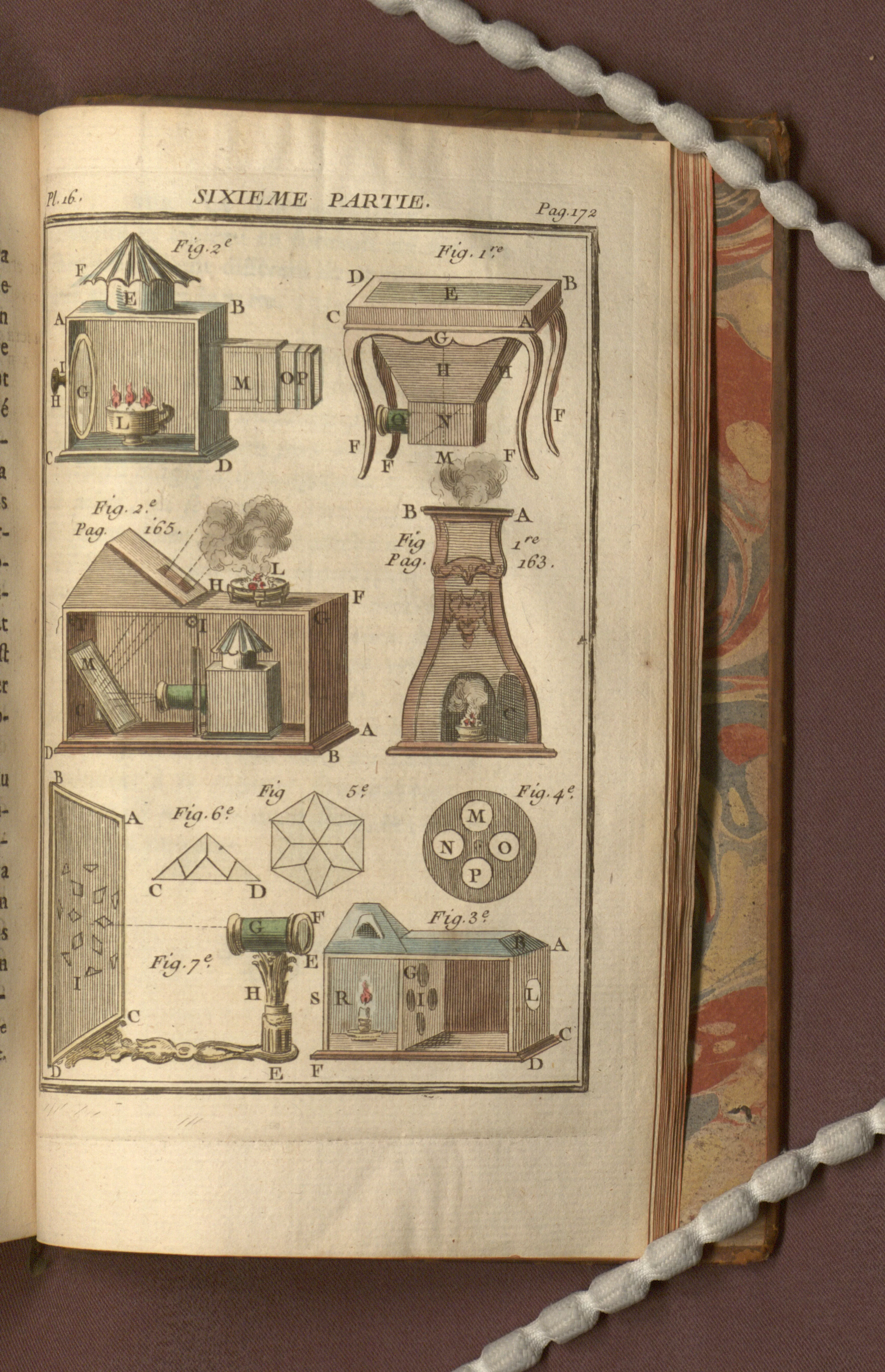Creation Date
1775
Height
16 cm
Width
14 cm
Medium
Genre
Description
The text and its accompanying plates delineate how to create optical instruments for recreational scientific experiments.
“Plate 16” features nine figures which illustrate devices used to create optical illusions. Three of the colored figures depict different forms of magic lanterns and how they are operated in order to project phantasmagoric illusions. The figure in the upper right corner of the plate is a portable camera obscura, constructed to resemble a side table or desk. The figures along the bottom of the plate depict the construction and use of a “Tableau Magique,” an illusion involving colorful moving projections.
M. Guyot’s sensuously hand-colored plates “offered a tantalizing array of apparatuses unfolding a succession of diverting appearances” for the late eighteenth-century amateur science enthusiast (Stafford, Artful Science 56). Aligned with the visual strategies and edifying aims of other rational recreations books, Guyot’s text, a French language example of the genre, again pairs the natural science of optics with instruments designed to create fantastic optical illusions and tricks, like the catoptrical mirrors, the magic lantern, and anamorphic images. As noted by Stafford, Guyot believed that despite the hard science behind them, these sorts of optical experiments and devices “demonstrated that, of all the senses, sight was the most prone to illusions,” no matter whether the historical context was one of rational enlightenment or subjective romanticism (Stafford, Artful Science 56). The ability to distinguish between the illusory and the real became one of the chief educational purposes of this type of rational recreations texts in the Romantic period (Groth 161).
Constructed with the lens and mirrors underneath, the camera obscura shown here more strongly resembles a drawing room contraption than a scientific apparatus; this device embodies the notion of “furniture-to-think-with,” and was consequently considered useful in both socialization and education, activities emphasized by Romantic rational recreations texts (Stafford, Artful Science11). Although composed of the same basic elements, including the focusing lens, glass mirror, and glass pane, the side table style apparatus undermines Jonathan Crary’s conception of the association between the camera obscura and vision in the Romantic period. Rather than interiorizing or decorporealizing vision by isolating the viewer within the apparatus, as Crary argues, the camera obscura converts this model of vision quite literally into a parlor trick, or at the very least denies the viewer a secluded, private hiding place (Crary 39). Finally, the juxtaposition of the camera obscura with not one but three different types of magic lanterns, as well as the “tableau magique” device on “Plate 16,” suggests that image projection apparatuses, what Crary calls the “counter-deployment of the camera obscura,” did in fact function similarly as additional or alternative models of vision in the Romantic period (Crary 33).
Locations Description
M. Guyot was a member of both the Académie des Sciences and the Société Littéraire et Militaire de Basançon.
Collection
Accession Number
Q164 G97
Additional Information
Bibliography
Blom, Philipp. Enlightening the World: Encyclopédie, The Book that Changed the Course of History. New York: Macmillan, 2005. Print.
Crary, Jonathan. Techniques of the Observer: On Vision and Modernity in the Nineteenth Century. Cambridge, MA: MIT Press, 1990. Print.
Darton, Robert. The Business of Enlightenment: A Publishing History of the Encyclopédie, 1775-1800. Cambridge, MA: Harvard UP, 1979. Print.
Groth, Helen. “Domestic Phantasmagoria: The Victorian Literary Domestic and Experimental Visuality.” South Atlantic Quarterly 108.1 (2009): 147-69. Print.
Guyot, M. Nouvelles Récréations Physiques et Mathématiques. Paris: Chez l’Auteur and Chez Gueffier, 1772-1775. Print.
Riskin, Jessica. “Amusing Physics.” Science and Spectacle in the European Enlightenment. Ed. Bernadette Bensaude-Vincent and Christine Blondel. Burlington: Ashgate, 2008. 43-64. Print.
Stafford, Barbara Maria. Artful Science: Enlightenment, Entertainment, and the Eclipse of Visual Education. Cambridge, MA: MIT Press, 1994. Print.
--- . “Revealing Technologies/Magical Domains.” Devices of Wonder: From the World in a Box to Images on a Screen. Ed. Barbara Maria Stafford and Frances Terpak. Los Angeles: Getty, 2001. 1-115. Print.
Warner, Marina. “Camera Ludica.” Eyes, Lies and Illusions: The Art of Deception. Ed. Laurent Mannoni, Werner Nekes, and Marina Warner. London: Hayward Gallery, 2004. 13-23. Print.

